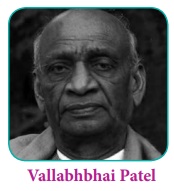Merger of Princely States
The adoption of the Constitution on November 26, 1949 was only the beginning of a bold new experiment by the infant nation. There were a host of other challenges that the nation and its leaders faced and they had to be addressed even while the Constituent Assembly met and started its job of drafting independent India’s constitution. Among them was the integration of the Indian States or the Princely States.
The task of integrating the Princely States into the Indian Union was achieved with such speed that by August 15, 1947, except Kashmir, Junagadh and Hyderabad, all had agreed to sign an Instrument of Accession with India, acknowledging its central authority over Defence, External Affairs and Communications.
The task of integrating these states, with one or the other Provinces of the Indian Union was accomplished with ease. The resolution passed at the All India States People’s Conference (December 1945 and April 1947) that states refusing to join the Constituent Assembly would be treated as hostile was enough to get the rulers to sign the Instrument of Accession in most cases. There was the offer of a generous privy purse to the princes. The rapid unification of India was ably handled and achieved by Sardar Home Minister in the Interim Cabinet was also entrusted with the States Ministry for this purpose. The People’s Movements exerted pressure on the princes to accede to the Indian union.

The long, militant struggle that went on in the Travancore State for Responsible Government culminating in the Punnapra–Vayalar armed struggle against the Diwan, Sir C.P. Ramaswamy, the Praja Mandal as well as some tribal agitations that took place in the Orissa region – Nilagiri, Dhenkanal and Talcher – and the movement against the Maharaja of Mysore conducted by the Indian National Congress all played a major role in the integration of Princely States.
Yet, there was the problem posed by the recalcitrant ruler of Hyderabad, with the Nizam declaring his kingdom as independent. The ruler of Junagadh wanted to join Pakistan, much against the wishes of the people. Similarly, the Hindu ruler of Kashmir, Maharaja Hari Singh, declared that Kashmir would remain independent while the people of the State under the leadership of the National Conference had waged a “Quit Kashmir” agitation against the Maharaja. It must be stressed here that the movement in Kashmir as well as the other Princely States were also against the decadent practice of feudal land and social relations that prevailed there.
“The police action” executed in Hyderabad within 48 hours after the Nizam declared his intentions demonstrated that India meant business. It was the popular anger against the Nizam and his militia, known as the Razakkars, that was manifest in the Telengana people’s movement led by the communists there which provided the legitimacy to “the police action”.

Though Patel had been negotiating with the Maharaja of Kashmir since 1946, Hari Singh was opposed to accession. However, in a few months after independence – in October 1947 – marauders from Pakistan raided Kashmir and there was no way that Maharaja Hari Singh could resist this attack on his own. Before India went to his rescue the Instrument of Accession was signed by him at the instance of Patel. Thus Kashmir too became an integral part of the Indian Union.
This process and the commitment of the leaders of independent India to the concerns of the people of Kashmir led the Constituent Assembly to provide for autonomous status to the State of Jammu and Kashmir under Article 370 of the Constitution.

Instrument of Accession: A legal document, introduced in Government of India Act, 1935, which was later used in the context of Partition enabling Indian rulers to accede their state to either India or Pakistan.














